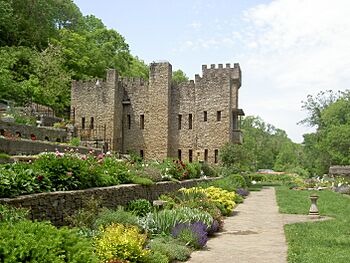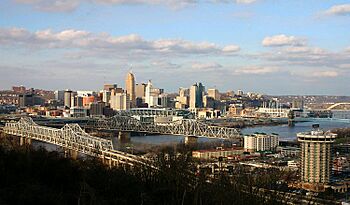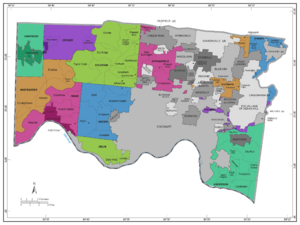Hamilton County, Ohio facts for kids
Quick facts for kids
Hamilton County
|
|||||
|---|---|---|---|---|---|
|
County
|
|||||
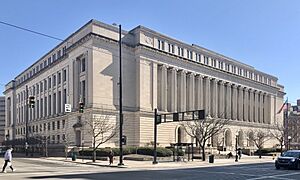
Hamilton County Courthouse
|
|||||
|
|||||
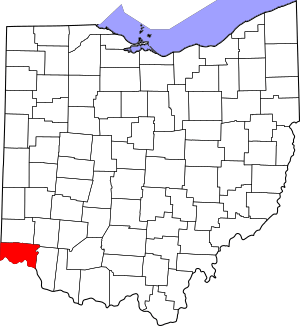
Location within the U.S. state of Ohio
|
|||||
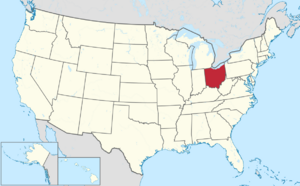 Ohio's location within the U.S. |
|||||
| Country | |||||
| State | |||||
| Founded | January 2, 1790 | ||||
| Named for | Alexander Hamilton | ||||
| Seat | Cincinnati | ||||
| Largest city | Cincinnati | ||||
| Area | |||||
| • Total | 413 sq mi (1,070 km2) | ||||
| • Land | 406 sq mi (1,050 km2) | ||||
| • Water | 6.7 sq mi (17 km2) 1.6%% | ||||
| Population
(2020)
|
|||||
| • Total | 830,639 | ||||
| • Estimate
(2023)
|
827,058 |
||||
| • Density | 2,011.2/sq mi (776.5/km2) | ||||
| Time zone | UTC−5 (Eastern) | ||||
| • Summer (DST) | UTC−4 (EDT) | ||||
| Congressional districts | 1st, 8th | ||||
Hamilton County is located in the southwestern corner of the U.S. state of Ohio. As of the 2020 census, the population was 830,639, making it the third-most populous county in Ohio. The county seat and most populous city is Cincinnati. The county is named for the first Secretary of the Treasury, Alexander Hamilton. Hamilton County is part of the Cincinnati-Middletown, OH-KY-IN Metropolitan Statistical Area.
History
The southern portion of Hamilton County was originally owned and surveyed by John Cleves Symmes, and the region was a part of the Symmes Purchase. The first settlers rafted down the Ohio River in 1788 following the American Revolutionary War. They established the towns of Losantiville (later Cincinnati), North Bend, and Columbia.
Hamilton County was organized in 1790 by order of Arthur St. Clair, governor of the Northwest Territory, as the second county in the Northwest Territory. Cincinnati was named as the seat. Residents named the county in honor of Alexander Hamilton, who was the first Secretary of the Treasury of the United States and a founder of the Federalist Party. Its original boundaries were those defined for the Symmes purchase contract in 1788: the Ohio River in the South, Great Miami River to the west, the Lesser Miami River to the east, and the Cuyahoga River to the North. Its area then included about one-eighth of Ohio and had about 2,000 inhabitants (not including the remaining Native Americans).
The county was greatly expanded in 1792 to include what is today the lower peninsula of Michigan. Since 1796, other counties were created from Hamilton, reducing the county to its present size. The county was the location of much of the Northwest Indian War before and after its organization.
The United States forcibly removed most of the Shawnee and other Indian peoples to move to locations west of the Mississippi River in the 1820s.
Rapid growth occurred during the 1830s and 1840s as the area attracted many German and Irish immigrants, especially after the Great Famine in Ireland and the revolutions in Germany in 1848.
During the Civil War, Morgan's Raid (a Confederate cavalry campaign from Kentucky) passed through the northern part of the county during the summer of 1863.
The Sharonville Engineer Depot was constructed by the United States Army in northern Hamilton County in 1942, and continued to be used by the General Services Administration and then the Defense Logistics Agency after 1949. It is currently mostly redeveloped for industrial purposes.
Geography
According to the U.S. Census Bureau, the county has a total area of 413 square miles (1,070 km2), of which 406 square miles (1,050 km2) is land and 6.7 square miles (17 km2) (1.6%) is water.
Adjacent counties
- Franklin County, Indiana (northwest)
- Dearborn County, Indiana (west)
- Butler County (north)
- Warren County (northeast)
- Clermont County (east)
- Campbell County, Kentucky (southeast)
- Kenton County, Kentucky (south)
- Boone County, Kentucky (southwest)
Geographic features
The county lies in a region of gentle hills formed by the slopes of the Ohio River valley and its tributaries. The Great Miami River, the Little Miami River, and the Mill Creek also contribute to this system of hillsides and valleys. No naturally occurring lakes exist, but three major humanmade lakes are part of the Great Parks of Hamilton County. The largest lake by far is Winton Woods Lake, covering 188 surface acres, followed by Miami Whitewater Lake, covering 85 surface acres, and Sharon Lake, covering 36 surface acres.
The county boundaries include the lowest point in Ohio, in Miami Township, where the Ohio River flows out of Ohio and into Indiana. This is the upper pool elevation behind the Markland Dam, 455 feet (139 m) above sea level.
The highest land elevation in Hamilton County is the Rumpke Sanitary Landfill at 1,045 feet (319 m) above sea level in Colerain Township.
Major highways
 I-71
I-71 I-74
I-74 I-75
I-75 I-275
I-275 US 22
US 22 US 27
US 27 US 42
US 42 US 50
US 50 US 52
US 52 US 127
US 127 SR 3
SR 3 SR 4
SR 4 SR 32
SR 32 SR 125
SR 125 SR 126
SR 126 SR 128
SR 128 SR 264
SR 264
Demographics
| Population of Hamilton County 1800–2020 | |||||||||||||||||||||||||||||||||||||||||||||||||||||||||||||||||||||||||||||||
|---|---|---|---|---|---|---|---|---|---|---|---|---|---|---|---|---|---|---|---|---|---|---|---|---|---|---|---|---|---|---|---|---|---|---|---|---|---|---|---|---|---|---|---|---|---|---|---|---|---|---|---|---|---|---|---|---|---|---|---|---|---|---|---|---|---|---|---|---|---|---|---|---|---|---|---|---|---|---|---|
|
|
||||||||||||||||||||||||||||||||||||||||||||||||||||||||||||||||||||||||||||||
| U.S. Decennial Census 1790-1960 1900-1990 1990-2000 2010-2020 |
|||||||||||||||||||||||||||||||||||||||||||||||||||||||||||||||||||||||||||||||
2020 census
As of the census of 2020, there were 830,639 people living in the county, for a population density of 2,045.91 people per square mile (791.08/km2). There were 379,015 housing units. The racial makeup of the county was 63.3% White, 25.2% Black or African American, 0.3% Native American, 3.0% Asian, 0.1% Pacific Islander, 2.4% from some other race, and 5.7% from two or more races. 4.4% of the population were Hispanic or Latino of any race.
There were 355,784 households, out of which 26.3% had children under the age of 18 living with them, 39.3% were married couples living together, 20.5% had a male householder with no spouse present, and 32.5% had a female householder with no spouse present. 34.3% of all households were made up of individuals, and 12.0% were someone living alone who was 65 years of age or older. The average household size was 2.26, and the average family size was 2.96.
22.6% of the county's population were under the age of 18, 60.5% were 18 to 64, and 16.9% were 65 years of age or older. The median age was 37.0. For every 100 females, there were 94.7 males.
According to the U.S. Census American Community Survey, for the period 2016-2020 the estimated median annual income for a household in the county was $66,878, and the median income for a family was $92,480. About 15.3% of the population were living below the poverty line, including 17.6% of those under age 18 and 10.8% of those age 65 or over. About 64.1% of the population were employed, and 41.8% had a bachelor's degree or higher.
2010 census
As of the 2010 census, there were 802,374 people, 333,945 households, and 197,571 families living in the county. The population density was 1,976.7 inhabitants per square mile (763.2/km2). There were 377,364 housing units at an average density of 929.7 per square mile (359.0/km2). The racial makeup of the county was 68.8% white, 25.7% black or African American, 2.0% Asian, 0.2% American Indian, 0.1% Pacific islander, 1.1% from other races, and 2.1% from two or more races. Those of Hispanic or Latino origin made up 2.6% of the population. In terms of ancestry, 31.0% were German, 14.7% were Irish, 7.7% were English, and 6.6% were American.
Of the 333,945 households, 29.7% had children under the age of 18 living with them, 39.4% were married couples living together, 15.4% had a female householder with no husband present, 40.8% were non-families, and 33.9% of all households were made up of individuals. The average household size was 2.34 and the average family size was 3.04. The median age was 37.1 years.
The median income for a household in the county was $48,234 and the median income for a family was $64,683. Males had a median income of $48,344 versus $37,310 for females. The per capita income for the county was $28,799. About 11.1% of families and 15.4% of the population were below the poverty line, including 22.9% of those under age 18 and 9.0% of those age 65 or over.
Population
The county's highest population was recorded in the 1970 U.S. Census. Since then, the county has lost population at an average rate of three percent per decade. Although Hamilton County is experiencing a decline in birth rates and has higher death rates in older age groups (cohorts), out-migration of residents is the key factor in population loss. In the last decade, this population loss has been reversed, and it is estimated that both Hamilton County and the City of Cincinnati have grown their populations. The Cincinnati Metropolitan Statistical Area, over the last three decades has seen a 19 percent increase in population. Much of the region's growth has been through movement of Cincinnati and Hamilton County residents into neighboring counties.
Education
K-12 education
Public elementary and secondary education is provided by 23 school districts:
- Cincinnati Public Schools
- Deer Park Community City
- Finneytown Local
- Forest Hills Local
- Indian Hill Exempted Village
- Lockland Local
- Loveland City
- Madeira City
- Mariemont City
- Milford Exempted Village
- Mount Healthy City
- North College Hill City
- Northwest Local
- Norwood City
- Oak Hills Local
- Princeton City
- Reading City
- Southwest Local
- St. Bernard - Elmwood Place City
- Sycamore Community
- Three Rivers Local
- Winton Woods City
- Wyoming City
In 2016, Cincinnati Public Schools had 35,000 students, 63% of which were African-American. The county also has a vocational school district, the Great Oaks Institute of Technology and Career Development. Parochial schools of various denominations add to this base. Among these the Roman Catholic Archdiocese of Cincinnati maintains a system of 108 elementary and 22 secondary schools, the ninth largest private school system in the United States.
Colleges and universities

|
|
Transportation
Major highways
Interstate 71, Interstate 74, Interstate 75, Interstate 471, and Interstate 275 serve the county. The Norwood Lateral and Ronald Reagan Cross County Highway are also prominent east–west thoroughfares in the county.
Railroads
CSX Transportation, Norfolk Southern, RailAmerica, and Amtrak.
Recreation
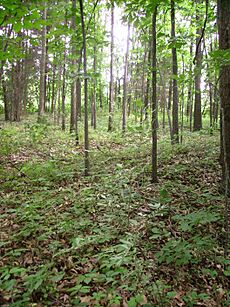
The county, in cooperation with the City of Cincinnati, operates the Public Library of Cincinnati and Hamilton County system with a main library and 41 branches. Major sports teams are listed under the communities in which they are located, primarily Cincinnati. The Great Parks of Hamilton County district resides within Hamilton County and maintains a series of preserves and educational facilities. Three of the largest parks within the system are Miami Whitewater Forest, Winton Woods, and Sharon Woods. The Hamilton County Fair is the oldest county fair in Ohio.
Communities
Cities
- Blue Ash
- Cheviot
- Cincinnati (county seat)
- Deer Park
- Fairfield (small part)
- Forest Park
- Harrison
- Village of Indian Hill
- Loveland (part)
- Madeira
- Milford (part)
- Montgomery
- Mount Healthy
- North College Hill
- Norwood
- Reading
- Sharonville (mostly)
- Springdale
- Wyoming
Villages
Townships
The following list includes townships that have existed within present-day Hamilton County, including those that no longer exist or remain only as paper townships. It does not include townships that became part of Butler, Warren, Clermont, Montgomery, and other counties.
- Anderson
- Cincinnati (defunct)
- Colerain
- Columbia
- Crosby
- Delhi
- Fulton (defunct)
- Green
- Harrison
- Miami
- Mill Creek (defunct)
- South Bend Township (defunct)
- Springfield
- Spencer (defunct)
- Storrs (defunct)
- Sycamore
- Symmes
- Whitewater
Census-designated places
- Blue Jay
- Brecon
- Bridgetown
- Camp Dennison
- Cherry Grove
- Coldstream
- Concorde Hills
- Covedale
- Delhi Hills
- Delshire
- Dent
- Dillonvale
- Dry Ridge
- Dry Run
- Dunlap
- Elizabethtown
- Finneytown
- Forestville
- Fruit Hill
- Grandview
- Groesbeck
- Highpoint
- Hooven
- Kenwood
- Loveland Park (part)
- Mack
- Madison Place
- Miami Heights
- Miamitown
- Monfort Heights
- Mount Healthy Heights
- New Baltimore
- New Burlington
- New Haven
- Northbrook
- Northgate
- Plainville
- Pleasant Hills
- Pleasant Run
- Pleasant Run Farm
- Remington
- Ridgewood
- Rossmoyne
- Salem Heights
- Shawnee
- Sherwood
- Sixteen Mile Stand
- Skyline Acres
- Taylor Creek
- Turpin Hills
- White Oak
Unincorporated communities
Neighborhoods of Cincinnati
- Avondale
- Bond Hill
- California
- Camp Washington
- Carthage
- Clifton
- College Hill
- Columbia-Tusculum
- Corryville
- CUF
- Downtown
- East End
- East Price Hill
- East Walnut Hills
- East Westwood
- English Woods
- Evanston
- Hartwell
- The Heights
- Hyde Park
- Kennedy Heights
- Linwood
- Lower Price Hill
- Madisonville
- Millvale
- Mount Adams
- Mount Airy
- Mount Auburn
- Mount Lookout
- Mount Washington
- North Avondale
- North Fairmount
- Northside
- O'Bryonville
- Oakley
- Over-the-Rhine
- Paddock Hills
- Pendleton
- Pleasant Ridge
- Queensgate
- Riverside
- Roselawn
- Sayler Park
- Sedamsville
- South Cumminsville
- South Fairmount
- Spring Grove Village
- Walnut Hills
- West End
- West Price Hill
- Westwood
- Winton Hills
See also
 In Spanish: Condado de Hamilton (Ohio) para niños
In Spanish: Condado de Hamilton (Ohio) para niños





